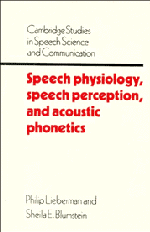Book contents
- Frontmatter
- Contents
- List of figures
- Preface
- Acknowledgements
- 1 Introduction
- 2 A qualitative introduction to the physiology of speech
- 3 Basic acoustics
- 4 Source–filter theory of speech production
- 5 Speech analysis
- 6 Anatomy and physiology of speech production
- 7 Speech synthesis and speech perception
- 8 Phonetic theories
- 9 Some current topics in speech research
- 10 Acoustic correlates of speech sounds
- Bibliography
- Index
1 - Introduction
Published online by Cambridge University Press: 05 June 2012
- Frontmatter
- Contents
- List of figures
- Preface
- Acknowledgements
- 1 Introduction
- 2 A qualitative introduction to the physiology of speech
- 3 Basic acoustics
- 4 Source–filter theory of speech production
- 5 Speech analysis
- 6 Anatomy and physiology of speech production
- 7 Speech synthesis and speech perception
- 8 Phonetic theories
- 9 Some current topics in speech research
- 10 Acoustic correlates of speech sounds
- Bibliography
- Index
Summary
The study of language and the sounds of speech can be traced back at least to the Greek and Sanskrit grammarians of the third and fourth centuries BC. The explicit study of speech science began in the eighteenth century when Ferrein (1741) attempted to explain how the vocal cords produced phonation. Ferrein's studies were not an isolated event. Kratzenstein (1780) and von Kempelen (1791) attempted to explain how the vowels and consonants of human speech were produced by synthesizing sounds using artificial “talking machines.” There indeed may have been earlier attempts at constructing talking machines; La Mettrie (1747) discusses some of these early attempts, but we lack detailed records. By the mid nineteenth century Müller (1848) had formulated the source–filter theory of speech production, which is consistent with the most recent data and still guides research on human speech as well as the vocal communications of other animals. Although Müller's theory was further developed later in the nineteenth century, particularly by Hermann (1894), the modern period of speech science is really quite recent, dating back to the late 1930s, where devices like the sound spectrograph, and techniques like high-speed photography, cineradiography, and electromyography made new data available. Quantitative studies like those of Chiba and Kajiyama (1941), Joos (1948), Peterson and Barney (1952), Stevens and House (1955), and Fant (1960) refined and tested the traditional phonetic theories of the nineteenth century and provided the framework for comprehensive, biologically-oriented studies of speech production, speech perception, and phonetics.
- Type
- Chapter
- Information
- Publisher: Cambridge University PressPrint publication year: 1988

